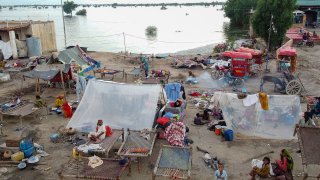
- From 1991 to 2000, global insured losses from floods was about $30 billion. In the next decade, global insured losses from floods was $40 billion and from 2011 to 2020, global insured losses from floods was $80 billion, according to Swiss Re.
- In the decade from 2011 to 2020, 82 percent of global economic losses from floods were uninsured, according to Swiss Re.
- The report comes as Pakistan is struggling to recover from deadly floods that have killed more than 1,000 people.
The cost of flood damage to insured property around the globe is jumping drastically, and climate change is one of several factors, according to a new report out Thursday from the insurance giant Swiss Re.
From 1991 to 2000, global insured losses from floods was about $30 billion. In the next decade, global insured losses from floods was $40 billion, and from 2011 to 2020, global insured losses from floods was $80 billion, according to Swiss Re.
In the first year of the next decade alone, 2021, insured losses were $20 billion, Swiss Re said.
Get top local stories in Connecticut delivered to you every morning. Sign up for NBC Connecticut's News Headlines newsletter.
That's only a fraction of the total losses from flooding. In the decade from 2011 to 2020, 82 percent of global economic losses from floods was uninsured, according to Swiss Re.
Population growth, the growth of cities, and the increasing intensity of flooding events due to climate change are to blame for the surge in the damage done by floods. "Climate change is increasing likelihood of high-intensity, heavy rain and short-duration floods events associated with tropical cyclones," the report from Swiss Re said.
Currently, Pakistan is struggling to recover from deadly floods that have killed more than 1,000 people and injured many more, according to António Guterres, the Secretary-General of the United Nations.
Money Report
"Pakistan is awash in suffering. The Pakistani people are facing a monsoon on steroids — the relentless impact of epochal levels of rain and flooding," Guterres said on Monday.
"As we continue to see more and more extreme weather events around the world, it is outrageous that climate action is being put on the back burner as global emissions of greenhouse gases are still rising, putting all of us – everywhere – in growing danger," Guterres said.
In the United States, almost 40% of the population lives in coastal counties and another 10% in floodplains.
"Despite the private flood insurance market gaining traction over the last few years, too many people are still not covered for flooding and the majority of those impacted by these events are uninsured, leaving them to pick up the pieces at their own expense," Keith Wolfe, president of property and casualty for Swiss Re in the US, said in a written statement.
Extreme rainfall can cause flooding anywhere, said Swiss Re.
"Flood risk is in a lot more places than your mortgage company tells you," Wolfe said.
For the insurance industry, the ability to properly insure properties for flooding risk is improving due to better date and more granular risk mapping, Swiss Re said. It's still not perfect, though. The accuracy for measuring flood risk has improved but it still "remains limited," the report said. .






